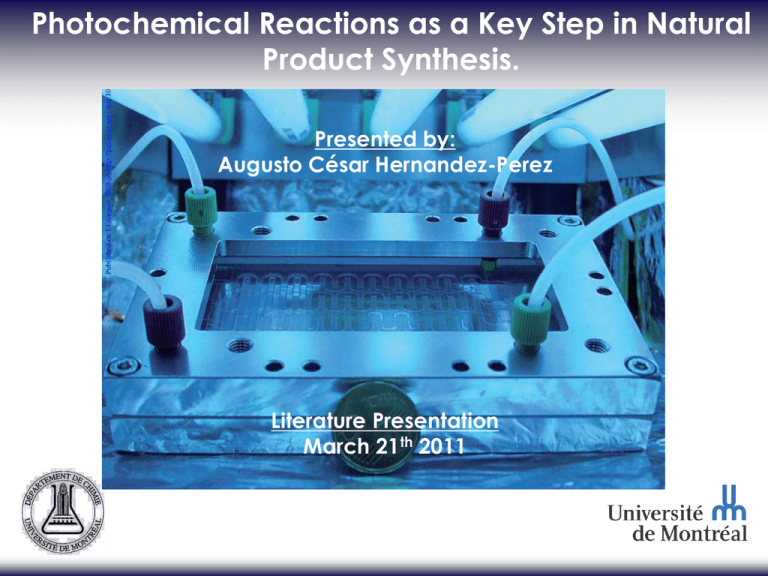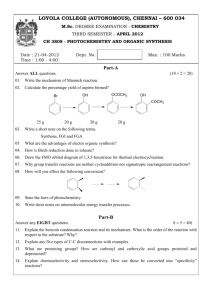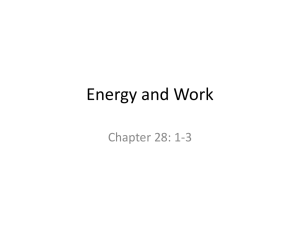Photocyclization.
advertisement

Photochemical Reactions as a Key Step in Natural Product Synthesis. Presented by: Augusto César Hernandez-Perez Literature Presentation March 21th 2011 About Me. Guatemala: Country of Mayan civilisation San Mateo Ixtatan 2 About Me. Pointe-Aux-Trembles UdM 3 Outline. Introduction • History • Basics in photochemistry • Equipment UV-mediated reactions • Photocyclizations •Photochemical Rearrangement 4 Introduction. Brief history • Photochemical reactions have been known for almost as long as chemistry • Most observations remained uninterpreted until the 19th century •Important work done in Italy by Ciamician, Silber and Paterno • After World War I, it became the province of the physical chemistry for 35 years • In the 50’s: general interest in photochemistry by the organic chemist due in part by natural product synthesis • In the 60’s: emergence of mechanistic organic photochemistry and merging of the organic and physical viewpoints. Arnold, D.R.; Baird, N.C.; Bolton, J.R.; Brand, J.C.D.; Jacobs, P.W.M.; de Mayo, P.; Ware, W.R. Photochemistry An Introduction, Academic Press Inc., New York, 1974 5 Introduction. Basic laws • Activation of reaction is provided by the absorption of a photon Energy conversion table =c/ E = h / nm kJmol-1 200 598 E = Nh = Nhc / 250 479 E = 1,197×105 kJmol-1/ 300 399 350 342 400 299 500 239 600 200 700 171 E = hc / h: Planck’s constant = : frequency 6.627×1034 Js (s-1) c: speed of light = 2,998 ×108 ms-1 N: Avagadro’s number = 6,023 ×1023 mol-1 Arnold, D.R.; Baird, N.C.; Bolton, J.R.; Brand, J.C.D.; Jacobs, P.W.M.; de Mayo, P.; Ware, W.R. Photochemistry An Introduction, Academic Press Inc., New York, 1974 6 Introduction. Orbital types •n orbitals: Non-bonding • and * orbitals: • and * orbitals: Overlap of p orbitals Not involve in most reaction Arnold, D.R.; Baird, N.C.; Bolton, J.R.; Brand, J.C.D.; Jacobs, P.W.M.; de Mayo, P.; Ware, W.R. Photochemistry An Introduction, Academic Press Inc., New York, 1974 7 Introduction. Electronic transition •Photochemical excitation: Involves the transfer of a electron from a lower orbital to a higher one E antibonding bonding Arnold, D.R.; Baird, N.C.; Bolton, J.R.; Brand, J.C.D.; Jacobs, P.W.M.; de Mayo, P.; Ware, W.R. Photochemistry An Introduction, Academic Press Inc., New York, 1974 8 Introduction. Photochemical reaction • Photochemically excited molecule: Non-radiative (deactivation) processes between states Radiative processes between states Intermolecular energy transfer Chemical reaction A + h’ (emission) A + heat (radiationless decay) A + h A* C* (change excited state) B B* + A (energy transfer) (i.e.: sensititzer) chemical reaction Arnold, D.R.; Baird, N.C.; Bolton, J.R.; Brand, J.C.D.; Jacobs, P.W.M.; de Mayo, P.; Ware, W.R. Photochemistry An Introduction, Academic Press Inc., New York, 1974 9 Introduction. Jablonski Diagram E: Energy E A: Photon absorption F: Fluorescence (R) Sn P: Phosphorescence (R) S2 S: Singlet state IC S1 T: Triplet state ISC A IC: Internal conversion (N-R) F P T1 ISC: Intersystem crossing (N-R) S0 Electronic ground state 10 Introduction. Electronic transition •Multiplicity: Singlet VS Triplet •Sum of the angular quantum number S in (2S+1) •Each electron has a value of 1/2 Paired spin: ½ - ½ =0 S = 0, multiplicty is 1 (singlet) Unpaired spin: ½ + ½ =1 S = 1, multiplicity is 3 (triplet) LUMO HOMO Antiparrallel Spin Paired Spin S1 Parrallel Spin Unpaired Spin T1 Arnold, D.R.; Baird, N.C.; Bolton, J.R.; Brand, J.C.D.; Jacobs, P.W.M.; de Mayo, P.; Ware, W.R. Photochemistry An Introduction, Academic Press Inc., New York, 1974 11 Equipment. Light sources • Sun: Free Not practical Example: 30 days in Cairo sunlight •Mercury lamp: Most popular Versatile • Laser: Monochromatic, coherent Possibility of extremely high light intensities Surface area low Use to solve special problems Horspool, W.h Aspect of organic photochemistry, Acedemic Press Inc., New York, 1976 12 Equipment. Hg lamps • Low pressure lamp: 4,010-6 atm 90% at 254nm intensity per area is low • Medium pressure lamp: 4,610-2 atm broader spectral distribution (265nm, 310nm, 635nm) high temperature • High pressure lamp: 100 atm Emission below 280nm is very weak high temperature Spectral emission form Hg arc lamps Horspool, W.h Aspect of organic photochemistry, Acedemic Press Inc., New York, 1976 13 Equipment. Filter and glassware • Choice of lamp: Irradiation between 250 nm – 450 nm • For greater degree of selectivity Use of cut-off filters (glass or solution) of cut-off / nm Chemical composition Below 250 Na2WO4 Below 305 SnCl2 in HCl (0,1M) Below 330 Na3VO4 (2M) Below 355 BiCl3 in HCl Above 450 CoSO4 + CuSO4 Horspool, W.h Aspect of organic photochemistry, Acedemic Press Inc., New York, 1976 14 Equipment. Setup Immersion well batch photochemical reactor: • Limited application for large-scale reaction occurs within a short radius of the lamp Efficiency is scale dependant • Others solutions Use various lamps Concentrated reaction mixture Hook, B.D.A.; Dohle, W.; Hirst, P.R.; Pickworth, M.; Berry, M.B.; Booker-Milburn, K.I. J. Org. Chem. 2005, 70, 7558-7564 15 Equipment. Reactor •Single pass continuous flow reactor: Use of traditional water-cooled immersion well FEP: Fluorinated ethylenepropylene Solvent resistant Polymeric material Excellent UV-transmission properties Hook, B.D.A.; Dohle, W.; Hirst, P.R.; Pickworth, M.; Berry, M.B.; Booker-Milburn, K.I. J. Org. Chem. 2005, 70, 7558-7564 16 Equipment. Micro-Reactor • Adopted for photochemical application: •Serpentine reactor: long path length (1,15m = 20 turns) Heat-exchanging channel on top Reagents pre-mixed or not Mikroglas chemtech GmbH, Galileo-Galilei-Str. 28 55129 Mainz, Germany http://www.mikroglas.de 17 Introduction. Natural product synthesis • UV light: High energy absorption of light facilitates reaction pathways that cannot be accessed by conventional methods • Access to various natural products 18 UV mediated-reactions • Photocyclizations 6 Photocyclization of trienes 6 Photocyclization of Stilbenes 6 Photocyclization of enamide 4 Photocyclization of pyridinum salts • Photochemical Rearrangement 19 Photocyclization. • Photocyclizations: light-induced pericylic ring closing reactions •6 Photocyclizations Photocyclization of Trienes Photocyclization of Enamides • 4 Photocyclizations Electrons Photochemical Thermic 4n Disrotatory Conrotatory 4n+2 Conrotatory Disrotatory A: Carbocycles B: Heterocyclic products C: X = NR: pyrrolines, dihydroindoles, hexahydrocarbazoles X=O: vinyl aryl ether Arnold, D.R.; Baird, N.C.; Bolton, J.R.; Brand, J.C.D.; Jacobs, P.W.M.; de Mayo, P.; Ware, W.R. Photochemistry An Introduction, Academic Press Inc., New York, 1974 20 Photocyclization. • Photocyclization of Trienes: Tridachiahydropyrone (1), marine-derived natural product isolated in 1996 Original structure assigned to 1 Unsual fused bicyclic pyrone-contaning ring system 1 Proposed Biosynthetic Origin of 1 Gavagnin, M.; Mollo, E.; Cimino, G.; Ortea, J. Tetrahedron Lett. 1996, 37, 4259-4262 Sharma, P.; Griffiths, N.; Moses, J. E. Org. Lett. 2008, 10, 4025-4027. Sharma, P.; Griffiths, N.; Moses, J. E. Synlett. 2010, 525 – 528 21 Photocyclization. • Photocyclization of Trienes: No trans diastereoisomer formed 22 Photocyclization. • Photocyclization of Trienes: •Others examples: Photodeoxytridachione Dictyodendrins B Ellipticine •Oxidation of intermediate cyclohexadiene: O2 in air, I2, (PhSe)2 Eade, S. J. ; Walter, M.W.; Byrne, C.; Odell, B.; Rodriguez, R.; Baldwin, J. E.; Adlington, R. M.; Moses, J. E. J. Org. Chem. 2008, 73, 4830-4839. Frstner, A.; Domostoj, M.M.; Scheiper, B. J. Am. Chem. Soc. 2006, 128, 8087 – 8094. Ishikura, M .; Hino, A.; Yaginuma, T.; Agata, I.; Katagiri, N., Tetrahedron 2000, 56, 193 – 207. 23 Photocyclization. • Photocyclization of Stilbenes: • Effective route to phenanthrene. • E/Z isomerisation possible. • Need to shift the equilibrium to the product. 24 Photocyclization. • Photocyclization of Stilbenes: • Problem of regioselectivity if X and Z are different: If Z = H atom or if Z is smaller than X; formation of undesired regioisomers Solution: Tether the ring if R is in meta or use a vinylbenzene 25 Photocyclization. • Photocyclization of Stilbenes: Santiagonamie (2) extracted from branches of shrub Berberis darwinii 1996 Exhibits wound healing properties Valencia, E.; Patra, A.; Freyer, A. J.; Shamma, M.; Fajardo, V. Tetrahedron Lett. 1984, 25, 3163. Markey, M. D. ; Fu, Y.; Kelly, T. R. Org. Lett. 2007, 9, 3255-3257. 2 26 Photocyclization. • Photocyclization of Stilbenes: 2 Benzofquinoline instead of Benzohisoquinoline Valencia, E.; Patra, A.; Freyer, A. J.; Shamma, M.; Fajardo, V. Tetrahedron Lett. 1984, 25, 3163. Markey, M. D. ; Fu, Y.; Kelly, T. R. Org. Lett. 2007, 9, 3255-3257. 27 Photocyclization. • Photocyclization of Stilbenes: Failure due to repulsive steric interaction between OMOM and PhNHCO Backup plan: formation of lactone before photocyclization Valencia, E.; Patra, A.; Freyer, A. J.; Shamma, M.; Fajardo, V. Tetrahedron Lett. 1984, 25, 3163. Markey, M. D. ; Fu, Y.; Kelly, T. R. Org. Lett. 2007, 9, 3255-3257. 28 Photocyclization. • Photocyclization of Stilbenes: Medium-pressure Hg lamp Markey, M. D. ; Fu, Y.; Kelly, T. R. Org. Lett. 2007, 9, 3255-3257. 29 Photocyclization. • Photocyclization of Enamides: 3 possible reaction products generated from zwitterion G H: Formed under oxidative conditions I: Formed by a suprafacial 1,5-H shift (absence of oxidative conditions) J: Formed under reductive conditions (NaBH4, MeOH) Ninomiya, I. J. Nat. Prod. 1992, 55, 541-564 Ninomiya, I.; Naito, T. Heterocycles 1981, 15, 1433-1462 30 Photocyclization. • Photocyclization of Enamides: Mappicine ketone (MPK) (3) : antiviral lead compound against herpes viruses 3 Pendrak, I .; Barney, S. Wittrock, R.; Lambert, D.M.; Kingsbury, W.D.; J. Org. Chem. 1994, 59, 2623 Kato, I.; Higashimoto, M.; Tamura, O.; Ishibashi, H. J. Org. Chem. 2003, 68, 7983-7989. 31 Photocyclization. • Photocyclization of Enamides: Low-pressure Hg lamp Kato, I.; Higashimoto, M.; Tamura, O.; Ishibashi, H. J. Org. Chem. 2003, 68, 7983-7989. 32 Photocyclization. • 4 Photocyclization: Based on pyridinium salts Initial contribution from Kaplan, Pavlik and Wilzbach Azabenzvalene Formation of azabenzvalene: * excitation K L M K: Direct traping of initially formed allylic cation L and M: Trapping of rearragement product Kaplan, L.; Pavlik, J. W.; Wilzbach, K. E.; J. Am. Chem. Soc., 1972, 94, 3283 King, R.A. ; Lüthi, H.P.; Schaefer, F.; Glarner, F.; Burger, U. Chem.-Eur. J. 2001, 7, 1734 33 Photocyclization. • 4 Photocyclization: Generates bicyclic aziridine which can undergo nucleophilic ring opening Common nucleophiles: H2O, MeOH, KOH, etc. Others nucleophiles can be used: Organocuprate reagents High yields with polar solvent Bicyclic aziridine: neutralisation prior concentration Aminocyclopentene: concentration prior neutralisation Damiano, T.; Morton, D.; Nelson, A. Org. Biomol. Chem. 2007, 5, 2735-2752 Zou, J.; Mariano, P. S. Photochem. Photobiol. Sci. 2008, 7, 393-404 Kaplan, L.; Pavlik, J. W.; Wilzbach, K. E.; J. Am. Chem. Soc., 1972, 94, 3283 34 Photocyclization. • 4 Photocyclization : (-)-swainsonine (4), potent glycosidase inhibitor product isolated from different plant species such as Asclepiadaceae, Convulaceae, Moraceae and Orchidaceae Polyhydroxylated Indozilidne alkaloid 4 Acetylcholine esterease Gellert, E. J. Nat. Prod. 1982, 45, 50 Pearson, W. H.; Ren, Y.; Powers J. D. Heterocycles 2002, 58, 421 Song, L.; Duesler, E. N.; Mariano, P. S. J. Org. Chem. 2004, 69, 7284 – 7293 35 Photocyclization. • 4 Photocyclization : •Others examples: (+)-mannostatin A (-)-allosamidine Ling, R.; Mariano, P.S. J. Org. Chem., 1998, 63, 6072. Li, J.; Lang, F.; Ganem, B. J. Org. Chem., 1998, 63, 3403 Zhao, Z.; Song, L.; Mariano, P.S. Tetrahedron Lett., 2005, 61, 8888 (+)-castanospermine 36 UV mediated-reactions • Photocyclizations • Photochemical Rearrangement Oxa-di--Methane Rearrangement (ODPM) Photo-Fries Rearrangement 37 Photochemical Rearrangements. • Oxa-di--Methane Rearrangement (ODPM): ,-unsaturated ketones undergo a rearrangement involving a formal 1,2-acyl migration and cyclopropane formation First example in 1966: 2 possibles processes upon irradiation: 1,3-acyl migration or ODPM ODPM proceeds via a triplet state to yield the corresponding cyclopropyl ketone Use of a sensitizer (i.e. acetophenone) to generate the triplet state Hixson, S.S.; Mariano, P.S.; Zimmerman, H.E. Chem. Rev. 1973, 73, 531-551. Zimmerman, H.E. Armesto, D. Chem. Rev. 1996, 96, 3065-3112. Hoffmann, N. Chem. Rev. 2008, 108, 1052-1103. 38 Photochemical Rearrangements. • Oxa-di--Methane Rearrangement (ODPM): Cleavage of bond in position to the photoexcited carbonyl group; acyl group migrates onto the neighbouring C=C bond High chemical yield High degree of stereoselectivity Very general for many cyclic ,-unsaturated ketones Givens, R. S.; Oettle, W. F. J. Chem. Soc., Chem. Commun. 1969, 1164-1165. Zimmerman, H.E. Armesto, D. Chem. Rev. 1996, 96, 3065-3112. 39 Photochemical Rearrangements. • Oxa-di--Methane Rearrangement : (-)-phellodonic acid (5) isolated from fermentation of fungus in Tasmania in 1993 Exhibits strong inhibitory activities towards various bacteria and cancer cells 5 Medium-pressure Hg lamp M. Stadler, T. Anke, J. Dasenbrock, W. Steglich, Z. Naturforsch. C: J. Biosci. 1993, 48, 545. Reekie, T. A. ; Austin, K. A. B.; Banwell, M. G. ; Willis, A. C. Aust. J. Chem. 2008, 61, 94-106 40 Photochemical Rearrangements. • Oxa-di--Methane Rearrangement : M. Stadler, T. Anke, J. Dasenbrock, W. Steglich, Z. Naturforsch. C: J. Biosci. 1993, 48, 545. Reekie, T. A. ; Austin, K. A. B.; Banwell, M. G. ; Willis, A. C. Aust. J. Chem. 2008, 61, 94-106 41 Photochemical Rearrangements. • Oxa-di--Methane Rearrangement : •Relief of steric compressions between Me and Bz group by photoenolization or -cleavage process M. Stadler, T. Anke, J. Dasenbrock, W. Steglich, Z. Naturforsch. C: J. Biosci. 1993, 48, 545. Reekie, T. A. ; Austin, K. A. B.; Banwell, M. G. ; Willis, A. C. Aust. J. Chem. 2008, 61, 94-106 42 Photochemical Rearrangements. • Oxa-di--Methane Rearrangement : •Others examples: (-)-hirsutene (-)-complicatic acid ()-capnellene ()-Magellanine Banwell, M.G.; Edwards, A.J.; Harfoot, G.J.; Jolliffe, K.A. J. Chem. Soc. Perkin Trans. 1 2002, 22, 2439-2441 Singh, V.; Prathap, S.; Porinchu, M. J. Org. Chem. 1998, 63, 4011-4017 Yen, C.-F.; Liao, C.-C. Angew. Chem. Int. Ed. 2002, 41, 4090-4093 43 Photochemical Rearrangements. • Fries Rearrangement: Require strong Lewis acid Recombination can occur in ortho or para position Horspool, W.h Aspect of organic photochemistry, Acedemic Press Inc., New York, 1976 44 Photochemical Rearrangements. • Photo-Fries Rearrangement: First observed in 1960 Does not involve carbonium ions Cleavage of C-O bond proceeds via a triplet state Formation of phenol if aryloxy radical escapes from solvent cage Does not require strong Lewis acid Mild synthetic pathway Horspool, W.h Aspect of organic photochemistry, Acedemic Press Inc., New York, 1976 45 Photochemical Rearrangements. • Photo-Fries Rearrangement : Kendomycin (6) is a potent endothelin receptor antagonist compound with remarkable antibacterial and cytostatic activity Isolated from different Streptomyces species 6 Medium-pressure Hg lamp Bode, H.B.; Zeeck, A. J. Chem. Soc. Perkin Trans. 1 2000, 3, 323 Bode, H.B.; Zeeck, A. J. Chem. Soc. Perkin Trans. 1 2000, 16, 2665 Magauer, T.; Martin, H.J.; Mulzer, J. Angew. Chem. Int. Ed. 2009, 48, 6032-6036 46 Photochemical Rearrangements. • Photo-Fries Rearrangement : Magauer, T.; Martin, H.J.; Mulzer, J. Angew. Chem. Int. Ed. 2009, 48, 6032-6036 47 Conclusion. Equipment • Use of continuous flow reactor • Possibilities to scale-up reaction Photochemical reaction • Light as the only reactant •Control in the product generated • Access to important fragment from simple molecules 48 Conclusion. 49











